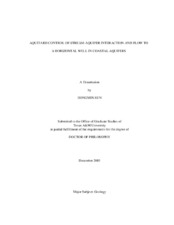| dc.description.abstract | This dissertation is composed of three parts of major contributions: In Chapter II, we developed a new conceptual model and derived a new semi-analytical model for flow to a horizontal well beneath a water reservoir. Instead of treating the leakage from aquitard as a source term inside the aquifer which is called Hantush’s assumption (1964), we linked flows in aquitard and aquifer by the idea of continuity of flux and drawdown. The result in this chapter is compared with that of Zhan and Park in 2003 which Hantush’s assumption is adopted at various hydraulic and well configurations. It shows that Hantush’s assumption becomes inaccurate in regions where vertical velocity components are significant. In Chapter III, we deal with the interaction of an aquifer with two parallel surface water bodies such as two streams or canals. In this chapter, new closed-form analytical and semi-analytical solutions are acquired for the pumping induced dynamic interaction between two streams and ground water for two different cases. In the first case, the sediment layers separating the streams from the aquifer ground water do not exist. In the second case, the two low permeable layers are considered. The effect of aquitard and water right competition is addressed in this chapter. This model can be used for interpreting and deriving hydrologic parameters of aquitard and aquifer when pumping occurs between two channels. It can also be used to predict stream depletion which is essential for water management and ecology conservation. In Chapter IV, we investigated the three dimensional upconing due to a finite-length of horizontal well and its critical conditions. The results are compared with those of vertical wells. The critical condition which includes the critical rise and the critical time at a certain pumping rate depends on the well length, the initial interface location, the well location, and the pumping rate. Our results show that horizontal well might be a better tool for coastal groundwater resources development. In real field applications, installing long wells as shallow as possible is always desirable for sustaining long periods of pumping with significant rates. | en |


